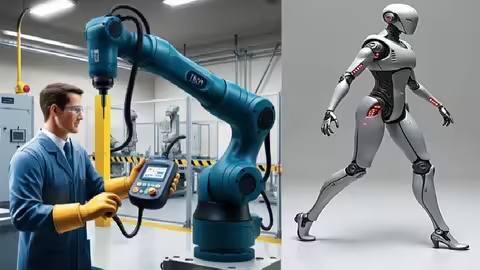
Published 5/2025
MP4 | Video: h264, 1920×1080 | Audio: AAC, 44.1 KHz
Language: English | Size: 3.61 GB | Duration: 7h 42m
Robot Kinematics, transformation matrices, DH Parameters,Robot configurations, Forward kinematics , frame assignments
What you’ll learn
Understand robot structure and components, including configurations, joints, actuators, end-effectors, and feedback systems.
Model forward kinematics of robotic manipulators using classical and modified Denavit-Hartenberg (DH) conventions.
Perform coordinate transformations using homogeneous transformation matrices and Euler angles for orientation analysis.
Apply frame assignment algorithms to real-world manipulators (e.g., SCARA, Cartesian, Cylindrical) and calculate home positions accurately.
Requirements
All essential concepts are introduced from the ground up, making it suitable to learn everything you need to know
Description
This comprehensive course on Robotics: Fundamentals and Kinematic Modeling (Part 1) is designed to provide students with a thorough understanding of the basic principles and mathematical modeling techniques fundamental to robotic manipulators. The course begins by introducing the core concepts of robotics, distinguishing between robots and manipulators, and exploring various robot configurations to highlight the diversity in robotic system design. It covers the types of joints used in manipulators, differentiating between active and passive joints, and explains key terminologies that define a robot’s capabilities, limitations, and task suitability. Students also learn about essential components such as stepper and servo motors, along with their feedback devices, critical for robot motion control.The curriculum then shifts focus to end effectors, discussing different types of grippers and the basics of robot programming, which lay the groundwork for robot operation and task execution. A significant emphasis is placed on transformation and orientation, where students study the need for matrix transformations in robotic manipulators. Topics include Euler angles, their role and singularities, and homogeneous transformations vital for describing robot motion and positioning in space.A major highlight is the detailed study of Denavit-Hartenberg (DH) parameters, covering both classical and modified conventions that are primarily used in forward kinematics to represent the geometry of a robot manipulator. Students learn systematic algorithms for assigning coordinate frames and computing DH parameters, with hands-on examples involving SCARA, spherical, articulated, cylindrical, and Cartesian manipulators. This includes calculating home positions and transformation sequences that enable accurate spatial representation of robotic links and joints.By integrating theory with practical applications, this course equips learners with the essential skills to model robotic manipulators mathematically, understand their kinematic behavior, and prepare for more advanced topics such as robot dynamics, control, and motion planning. It is ideal for engineering students, researchers, and professionals aiming to build a strong foundation in robotics.
Overview
Section 1: Introduction to Robotics
Lecture 1 Introduction
Lecture 2 Robot vs Manipulator
Lecture 3 Different Robot Configurations
Lecture 4 Types of Joint in manipulators
Lecture 5 Active Joint vs Passive Joint
Lecture 6 Key terminologies used to define robot or manipulator capabilities, limitations
Lecture 7 Stepper Motor vs Servo Motor
Lecture 8 Feedback devices
Section 2: End Effectors & Robot Programming
Lecture 9 End effectors
Lecture 10 Types of Grippers
Lecture 11 Robot Programming & its Types
Section 3: Transformation and Orientation in Robotics
Lecture 12 Need Matrix Transformation in Robotic Manipulators (Homogeneous Transformation)
Lecture 13 Euler angles
Lecture 14 Euler Angle Rotation Sequences
Lecture 15 Initial position for Body and space frame for defining extrinsic Euler angles
Lecture 16 Final Rotation Matrix for XYZ Convention
Lecture 17 Role of Euler Angle in a Manipulator
Lecture 18 Singularities in Euler Angles
Lecture 19 Homogeneous Transformation
Lecture 20 Transformations in Robotic Manipulators
Section 4: DH Parameters and Frame Assignments (Forward Kinematics)
Lecture 21 What is the need to study & apply DH Parameters in spatial linkages/ manipulator
Lecture 22 Classical DH Parameters with four sequence of operation, from frame {i-1} to {i}
Lecture 23 Procedure for Transformation from initial frame {i-1} to final frame {i}
Lecture 24 Modified DH Parameters with four sequence of operation, from frame {i-1} to {i}
Lecture 25 Procedure for Transformation from initial frame {i-1} to final frame {i}
Lecture 26 Classical DH Parameters VS Modified DH Parameters
Section 5: Coordinate Systems and DH Applications in different Robotic Configurations
Lecture 27 Right-Hand Rule for Coordinate System (Right-Handed Coordinate System)
Lecture 28 Frame for spatial linkages or manipulator in classical DH convention
Lecture 29 Frame for spatial linkages or manipulator for Modified DH convention
Lecture 30 Algorithm for Frame Assignment & DH (Classical) Parameter Calculation
Lecture 31 Classical DH Parameters: SCARA (RRPR) Robotic Manipulator
Lecture 32 Home position for SCARA (RRPR) Robotic Manipulator using Classical DH convention
Lecture 33 Algorithm for Frame Assignment & DH (Modified) Parameter Calculation
Lecture 34 Modified DH Parameters: SCARA (RRPR) Robotic Manipulator
Lecture 35 Home position for SCARA (RRPR) Robotic Manipulator using Modified DH convention
Lecture 36 Modified DH Parameters: Spherical (RRP) Manipulator
Lecture 37 Home position for Spherical (RRP) Manipulator using Modified DH convention
Lecture 38 Modified DH Parameters: Articulated (RRR) Manipulator
Lecture 39 Home position for Articulated (RRR) Manipulator using Modified DH convention
Lecture 40 Modified DH Parameters: Cylindrical (RPP) Manipulator
Lecture 41 Home position for Cylindrical (RPP) Manipulator using Modified DH convention
Lecture 42 Modified DH Parameters: Cartesian (PPP) Manipulator
Lecture 43 Home position for Cartesian (PPP) Manipulator using Modified DH convention
This course is ideal for undergraduate engineering students, robotics enthusiasts, and aspiring professionals who are interested in understanding the fundamental principles of robotics. It is also well-suited for learners from mechanical, electrical, electronics, or computer engineering backgrounds who want to build a strong foundation in robotic kinematics, modeling, and motion analysis. Since no prior experience is required, it is accessible to beginners as well as those seeking to reinforce their core knowledge before advancing to dynamics and control in robotics.
Password/解压密码www.tbtos.com
转载请注明:0daytown » Robotics: Fundamentals And Kinematic Modeling (Part 1)